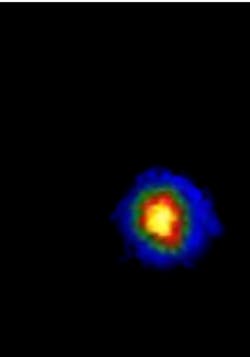Researchers in Germany have demonstrated the trapping of ions using optical fields in a tour-de-force experiment that has long been held to be an impossibility. Tobias Schaetz and his colleagues at the Max Planck Institute for Quantum Optics (Garching, Germany) used standard radio-frequency (RF) trapping techniques, but ramped them down in such a way that the trapping could be maintained with a laser ramping up.
Ion trapping by RF has been known for 60 years. In more recent decades, the field of optical trapping of neutral atoms has come into its own. "The question is: Why did it take thirty years longer to trap atoms rather than ions?" said Schaetz. "Easy—ions have charge, so you can directly couple them with electromagnetic fields."
Despite the fact that radio waves and light are, in effect, simply two different colors of the same electromagnetic radiation, the degree of trapping between the two approaches is distinctly different—the depth of the potential well created by RF fields is some six orders of magnitude greater for ions than for neutral atoms in an optical field. This means that any stray electric fields around a trapped ion would tend to swamp the "holding power" of the optical field, and an ion would make a swift but unpredictable departure from the trap—making it seem an experimental impossibility to trap ions with laser light alone.
Engineered crossover
Now Schaetz's team has combined the two techniques to great effect by engineering the crossover between the two regimes with the benefit of tiny, controllable DC electrodes that can counterbalance any stray fields. "We first store the ion in an RF trap, reduce its strength more and more, and look where the ion would like to escape to," he says. "We reduce the impact of stray fields, then switch on the laser and see if it survives in this optical dipole trap."
To prove that the ions are in fact trapped, the team switched the RF field back on and imaged the trapped ions (see figure). Lifetimes of the trapped ions in the trap are on the order of a few milliseconds, but the team points out that the limitation is caused by the laser wavelength being insufficiently detuned from a resonance of the trapped magnesium ions.1
The detuning, at least, was a problem easily solved with the benefit of a commercially available laser emitting at 1120 nm. "The most important thing for us is the fact that the lifetime is consistent with heating due to trapping, not due to fluctuating stray fields heating up the ions," Schaetz notes.
With the benefit of such a finely tuned hybrid approach, Schaetz says a number of exciting experiments becomes possible in areas ranging from quantum-information science to semiconductors.
"People don't know yet if antimatter goes up or down in gravity; up to now, they only had charged antimatter particles in traps, and you never know if it is the fields or gravity that moves them," says Schaetz. "With these ions in optical traps, you can also dream of having ions and atoms in the same optical lattice. If you think about solid-state physics, a lot of people are interested in defects or tunneling effects of electrons in semiconductors."
In short, he explains, the dogmatic separation of ion- and atom-trapping experiments can now come to a close. "Ions and atoms should once again be treated the same way," he says.
REFERENCE
1. C. Schneider et al., Nature Photon., doi: 10.1038/NPHOTON.2010.236 (2010).
